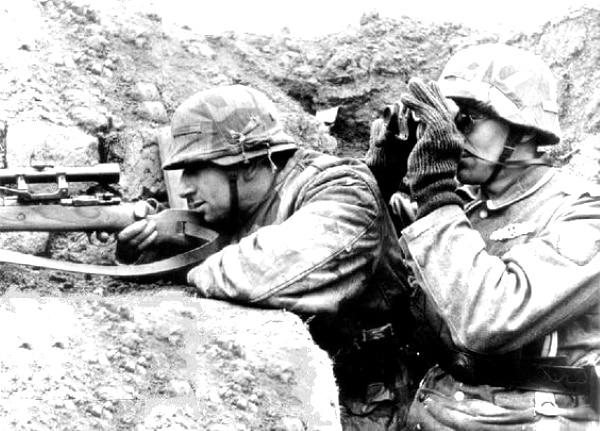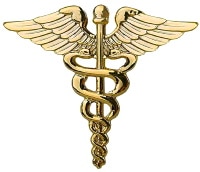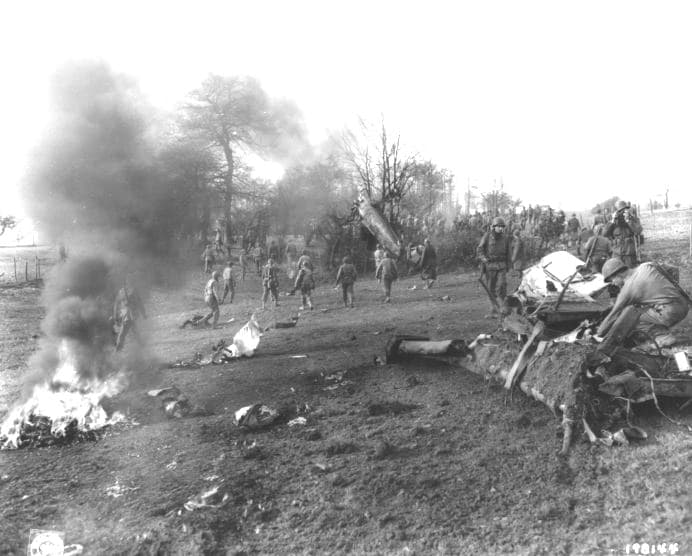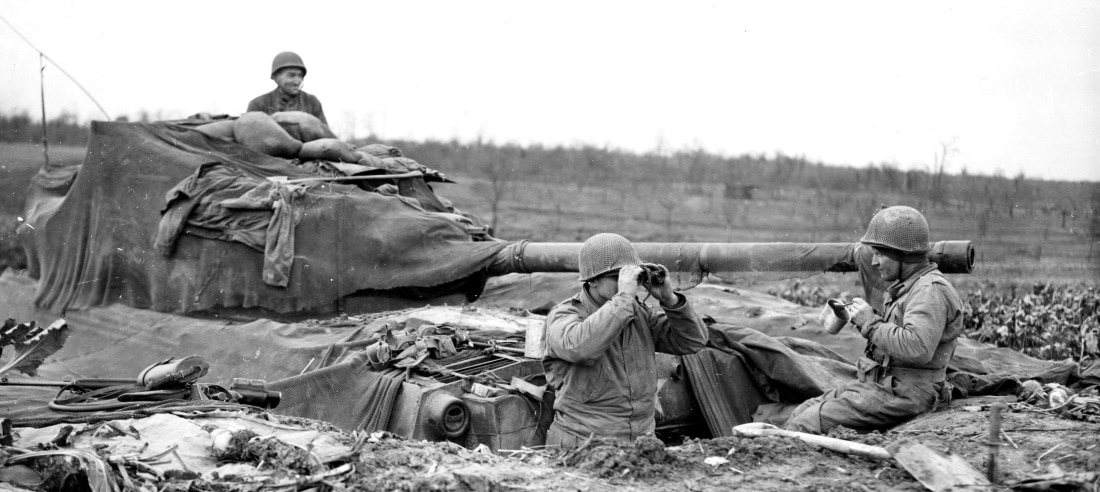
 On Dec 2, T/5 Nuay, the China-born Squadron draftsman, was wounded by a mortar shell in the command post and was evacuated. A Troop remained in contact with B Troop, 102-CRS on the left. During the night, the listening post patrol went to the vicinity of (962225) on Dec 3. During the night of Dec 4, Cpl Leone took a patrol of four men to the houses at (94702250) and (94952240), and without being observed determined that they were enemy occupied. Again on Dec 5, a patrol of 4 men under Sgt Schulse examined the pillbox at (954225) and found it to have been demolished by a unit previously occupying the area. With the mission of reporting on the pillbox at (961238), a patrol under Sgt Turner proceeded there under cover of darkness and upon returning without incident, reported the pillbox was constructed with the entrance on the southwest side and gun ports on the north, south, and southeast. Cpl Pace took a midnight patrol on Dec 8 which observed German activity in a house at (947226).
On Dec 2, T/5 Nuay, the China-born Squadron draftsman, was wounded by a mortar shell in the command post and was evacuated. A Troop remained in contact with B Troop, 102-CRS on the left. During the night, the listening post patrol went to the vicinity of (962225) on Dec 3. During the night of Dec 4, Cpl Leone took a patrol of four men to the houses at (94702250) and (94952240), and without being observed determined that they were enemy occupied. Again on Dec 5, a patrol of 4 men under Sgt Schulse examined the pillbox at (954225) and found it to have been demolished by a unit previously occupying the area. With the mission of reporting on the pillbox at (961238), a patrol under Sgt Turner proceeded there under cover of darkness and upon returning without incident, reported the pillbox was constructed with the entrance on the southwest side and gun ports on the north, south, and southeast. Cpl Pace took a midnight patrol on Dec 8 which observed German activity in a house at (947226).
A German deserter surrendered at (955229) on Dec 10. During the night of Dec 11, Sgt Abrams and 3 men established a listening post at (959230). Sgt Schulse was credited with hitting a German with one shot as he crossed the Konzen highway. On Dec 12, S/Sgt Briglie went out with three men before dawn to investigate a reported AT ditch across the highway at Konzen. At first light, they arrived at the designated spot and found the report to be in error. They were suddenly observed and came under aimed small arms and machine gun fire which dispersed them. S/Sgt Briglie returned, wounded by a hand grenade, and reported he knew nothing of the whereabouts of the other three men. Later the same night Fedak, Garoia, and Lapa returned. They had been in hiding all day in the cellar of a house while Germans came and went upstairs.
On the night of Dec 2, Lt Portorfields’s 1st Platoon of B Troop laid machine gun fire on a section of Konzen known to be occupied by the enemy. This was followed shortly by a time-on-target (TOT) concentration fired by both E Troop and the 62-FAB. The intent was to arouse the German’s curiosity and cause him to leave his shelter to investigate the machine gun fire, then to kill him with a powerful artillery blow. Due to darkness, the results were unknown except for scattered small arms fire in return. On Dec 8, T/5 Misch and a daylight patrol found that the pillbox at (943206) was nothing but a large rock. On the same night a patrol under Sgt Rusen with 7 of his own men and engineer mine sweeping team, swept the roads up to (943207) without finding mines or meeting the enemy. Due to the effect of buried shrapnel on the mine detector, the operation was quite lengthy and tedious. On Dec 10, Cpl Sousa took out a night listening post patrol to (947224) where enemy activity and voices were clearly heard. On Dec 14, a section of TDs was attached to the 2nd Platoon and put into position. On the same day, S/Sgt Whittard was lightly wounded but not evacuated when an artillery shell hit his house command post. The B Troop commander, Lt Joseph R. Sain, was promoted to the rank of Capt on December 7.
C Troop continued to defend from its trenches on top of the Hills surrounding Monschau. On the night of Dec 2, a machine gun position was moved forward to (94501850) and dug-in. On Dec 5, three C Troopers in charge of an engineer sergeant went out to fix the warning flares on the concertina wire. The sergeant accidentally tripped a friendly booby trap wounding the entire patrol to the extent that the sergeant, T/5 Jordan, and Pvt Nemeth had to be evacuated. After medical treatment, Pvt Dunlap was able to return to duty.
 Sniper fire increased daily causing no damage until Dec 12, when Pvt La Fazia was wounded while entering a dugout. Listening posts continued in operation well forward of the Main Line of Resistance. On Dec 15, T/5 Van Order and T/5 Anderson volunteered to go out and get the sniper. Before dawn, they departed on their mission with T/5 Anderson carrying an SCR-300 radio and by first light were in position at (952187). As the Germans came down a trail carrying his rifle, T/5 Van Order hit him at 100 yards with one shot. Both men then carried the wounded prisoner to the bottom of the stoop hill into Monschau but he died before receiving medical attention.
Sniper fire increased daily causing no damage until Dec 12, when Pvt La Fazia was wounded while entering a dugout. Listening posts continued in operation well forward of the Main Line of Resistance. On Dec 15, T/5 Van Order and T/5 Anderson volunteered to go out and get the sniper. Before dawn, they departed on their mission with T/5 Anderson carrying an SCR-300 radio and by first light were in position at (952187). As the Germans came down a trail carrying his rifle, T/5 Van Order hit him at 100 yards with one shot. Both men then carried the wounded prisoner to the bottom of the stoop hill into Monschau but he died before receiving medical attention.
They then volunteered to return to the ambush and await anyone who might come looking for the sniper. They waited all day in vain and returned under cover of darkness. The sniping, which had wounded an officer and two men, thereafter ceased. Lt James Farmer, formerly of B Troop, returned from the hospital after recovering from wounds and was assigned as Executive Officer of C Troop.
From its battery positions in Mützenich, E Troop fired 2548 rounds during the period on fire missions observed by its own forward Obs, those of the 62-FAB, and outposts of units on the line. Unobserved harassing missions were executed nightly. With the helpful cooperation of Capt Hazoltine, the liaison officer from the 62-FAB, the service of their Piper Cub observation plane was made available to the Squadron, and on several occasions, it adjusted fire missions for E Troop using direct radio communication. On Dec 5, at the request of Fox Co, the fire was adjusted upon a self-propelled weapon firing HE directly at Fox positions. The gun was silenced. Later, S/Sgt Zuckoff at CP #1 adjusted on Germans digging-in at (955017), and five casualties were definitely observed. On Dec 7, the first close counter-battery fire was received, two rounds exploding between gun positions without causing damage or casualties. Large caliber friendly batteries began to move in and take up positions on Dec 12. For artillery, they moved well forward, one battalion of 155-MM howitzers setting up behind Monschau, in the front of the C Troop’s mortars.
During Dec 13, a troop CP adjusted a mission on enemy infantry west of Roetgen with air bursts followed by a ground effect (Proximity Fuze), completely dispersing the personnel. An estimated 20 to 25 casualties were inflicted and six litter teams were seen in operation. A battery of 155-MM Long Toms set up behind the command post and, in supporting units to the north, broke all the windows in the area.
 On Dec 5, 1/Sgt Loak and his driver narrowly escaped injury when their bantam was hit by a 150-MM shell while they took cover in a ditch along the highway in Mützenich. During the period Fox Co kept the Stillbusch draw and its environs constantly under surveillance by day and night patrols, none of which contacted the enemy. On Dec 9, Pfc Seitz led a patrol to (949199) where they discovered a pillbox to be unoccupied. Another patrol under Sgt Petrucci, on Dec 12, reconnoitered beyond the winding road to (945193). Due to the character of the terrain and the proximity of enemy-occupied pillboxes and emplacements, patrolling in the Monschau draw was limited to listening posts. Lt Jack and Pvt Douvris were wounded by a sniper on Dec 14. This marksman, who had also deliberately killed a seven-year-old German girl, is believed to be the same sniper that was brought in by T/5 Van Order and T/5 Anderson of C Troop on Dec 15.
On Dec 5, 1/Sgt Loak and his driver narrowly escaped injury when their bantam was hit by a 150-MM shell while they took cover in a ditch along the highway in Mützenich. During the period Fox Co kept the Stillbusch draw and its environs constantly under surveillance by day and night patrols, none of which contacted the enemy. On Dec 9, Pfc Seitz led a patrol to (949199) where they discovered a pillbox to be unoccupied. Another patrol under Sgt Petrucci, on Dec 12, reconnoitered beyond the winding road to (945193). Due to the character of the terrain and the proximity of enemy-occupied pillboxes and emplacements, patrolling in the Monschau draw was limited to listening posts. Lt Jack and Pvt Douvris were wounded by a sniper on Dec 14. This marksman, who had also deliberately killed a seven-year-old German girl, is believed to be the same sniper that was brought in by T/5 Van Order and T/5 Anderson of C Troop on Dec 15.
 Lt Jack had been evacuated once before during the Normandy breakthrough. The Squadron Medical Detachment continued to operate its infirmary in Monschau. During the period the battle casualties treated consisted of twelve wounded. Several civilians were also treated for wounds resulting from the German shelling. On Dec 12, the inoculation of the entire Squadron against Typhus was accomplished. The various sections of HQs and Service Troop (Rear Echelon) continued to efficiently operate in their duties of servicing the Squadron. Except for several enemy planes over their bivouac on Dec 3, no activity was reported.
Lt Jack had been evacuated once before during the Normandy breakthrough. The Squadron Medical Detachment continued to operate its infirmary in Monschau. During the period the battle casualties treated consisted of twelve wounded. Several civilians were also treated for wounds resulting from the German shelling. On Dec 12, the inoculation of the entire Squadron against Typhus was accomplished. The various sections of HQs and Service Troop (Rear Echelon) continued to efficiently operate in their duties of servicing the Squadron. Except for several enemy planes over their bivouac on Dec 3, no activity was reported.
During the night of Dec 15/16, numbers of large enemy planes (Junker) were heard over the Squadron sector, and reports of paratroopers being dropped in the rear areas began 
 to come in from higher HQs. On this same night, it was decided to increase the barbed wire and flare field in the deep draw southeast of Monschau, which was defended by the 2nd Platoon of Fox Co. At 0200, E Troop placed a twenty-minute concentration on the Menzerath Hills using 180 rounds out the night to complete the task retiring through the Fox Co tank positions at 0445 on the morning of Dec 16. There was no activity of any kind for the next forty-five minutes. On Dec 16 without warning and at 0525, the entire squadron front was subjected to a terrific barrage of artillery, mortar, and rocket fire. A series of time on target concentrations, starting on the MLR, rolled on back to the artillery installations three thousand yards or more to the rear.
to come in from higher HQs. On this same night, it was decided to increase the barbed wire and flare field in the deep draw southeast of Monschau, which was defended by the 2nd Platoon of Fox Co. At 0200, E Troop placed a twenty-minute concentration on the Menzerath Hills using 180 rounds out the night to complete the task retiring through the Fox Co tank positions at 0445 on the morning of Dec 16. There was no activity of any kind for the next forty-five minutes. On Dec 16 without warning and at 0525, the entire squadron front was subjected to a terrific barrage of artillery, mortar, and rocket fire. A series of time on target concentrations, starting on the MLR, rolled on back to the artillery installations three thousand yards or more to the rear.
 An estimated 200 rounds fell in the immediate vicinity of the Squadron command post, and the main supply route, road Monschau – Eupen, received and followed, throughout the day, by severe interdiction and harassing fires as well as concentrations on our known emplacements. Obviously, the enemy was attempting to isolate the Monschau area by fire and this in itself was a tip-off for the attack which followed. All telephone communications were thoroughly disrupted with the first hail of enemy shells, and the Squadron went on the air. Lines crews, made up of volunteer radio operators and electricians, were out and working on the severed wires, long before the artillery had lifted. T/5 Hanson and Carducci, from the HQs Plat. of B Troop, raced back from Mützenich to the Assault Gun Battery, their vehicle torn by shell fragments, to restore vital communications with the guns.
An estimated 200 rounds fell in the immediate vicinity of the Squadron command post, and the main supply route, road Monschau – Eupen, received and followed, throughout the day, by severe interdiction and harassing fires as well as concentrations on our known emplacements. Obviously, the enemy was attempting to isolate the Monschau area by fire and this in itself was a tip-off for the attack which followed. All telephone communications were thoroughly disrupted with the first hail of enemy shells, and the Squadron went on the air. Lines crews, made up of volunteer radio operators and electricians, were out and working on the severed wires, long before the artillery had lifted. T/5 Hanson and Carducci, from the HQs Plat. of B Troop, raced back from Mützenich to the Assault Gun Battery, their vehicle torn by shell fragments, to restore vital communications with the guns.
 For a brief period, A Troop, 5000 yards to the north, was kept in contact by a lone operator, T/4 Ruggiere of B Troop who stuck to his radio car to relay traffic in spite of the continuous shelling which literally rocked his vehicle. At approximately 0600, the enemy artillery fire lessened and all units, now thoroughly alert, waited in the last remaining hours of darkness for the expected enemy attack. At 0605, S/Sgt Bielicki, commanding the 2nd Plat. of Fox Co reported hearing the noise of enemy movement in force in the Menzerath Hills, and on the Rohren and Hammer Roads.
For a brief period, A Troop, 5000 yards to the north, was kept in contact by a lone operator, T/4 Ruggiere of B Troop who stuck to his radio car to relay traffic in spite of the continuous shelling which literally rocked his vehicle. At approximately 0600, the enemy artillery fire lessened and all units, now thoroughly alert, waited in the last remaining hours of darkness for the expected enemy attack. At 0605, S/Sgt Bielicki, commanding the 2nd Plat. of Fox Co reported hearing the noise of enemy movement in force in the Menzerath Hills, and on the Rohren and Hammer Roads.
 At 0615, the word came from A Troop of an enemy attack on the positions of the 78-ID in Kesternich. Simultaneously, the 2nd Platoon of Fox Co was attacked by three platoons of the 3rd Co, 1st.Bn, 751.Regiment of the 326.Volks-Grenadier-Division. Despite the severe shelling he had just received, and the fact that all wire communication to his widely separated tank section had gone out. Given only a few minutes warning of the enemy’s approach, he found time to report his troop HQs and to coordinate the following plan within his platoon, all guns and tanks were manned, but the fire was to be held, the enemy was to be allowed to approach to the very outposts when, upon the signal burst from his (the S/Sgt’s) gun, all positions would open fire. 37-MM tank guns were loaded with canister and the men united. As the leading elements of the German infantry reached the outer perimeter of the platoon’s wire, a ground flare was tripped. All weapons commenced firing instantly, and illuminating shells from a 60-MM mortar lit up the entire area.
At 0615, the word came from A Troop of an enemy attack on the positions of the 78-ID in Kesternich. Simultaneously, the 2nd Platoon of Fox Co was attacked by three platoons of the 3rd Co, 1st.Bn, 751.Regiment of the 326.Volks-Grenadier-Division. Despite the severe shelling he had just received, and the fact that all wire communication to his widely separated tank section had gone out. Given only a few minutes warning of the enemy’s approach, he found time to report his troop HQs and to coordinate the following plan within his platoon, all guns and tanks were manned, but the fire was to be held, the enemy was to be allowed to approach to the very outposts when, upon the signal burst from his (the S/Sgt’s) gun, all positions would open fire. 37-MM tank guns were loaded with canister and the men united. As the leading elements of the German infantry reached the outer perimeter of the platoon’s wire, a ground flare was tripped. All weapons commenced firing instantly, and illuminating shells from a 60-MM mortar lit up the entire area.
In the resulting light, the enemy was soon to be in headlong retreat, back along the Röhren and Höfen roads. C Troop, on the left flank of this section, placed 81-MM mortar fire on the routes of withdrawal, and artillery defensive fires were called for and maintained until daylight. Lt Pepper, troop executive officer, brought reinforcements to the platoon from the Hqs Co and, at 0745, the enemy counter-attacked from the dense cover of the Menzerath Hill. Due to superior numbers and the most aggressive section, the enemy was partly successful in infiltration between the two tank sections, following the bed of the Roer River. As the enemy build up in thin wedge increased, endangering the flanks of the platoon’s positions, Sgt Messane, a tank commander, seized a light machine-gun and bravely exposing himself to the enemy fire, placed it in action to close the gap. He was immediately reinforced, and the enemy repulsed. German casualties as a result of these two actions were severe (32) but, due to the continued conflict in this area for the succeeding 48 hours, could not be accurately counted.
 The nearest enemy dead, as a result of the first attack, had fallen only 50 yards from the platoon outposts (13 in number, counted by S/Sgt Bielicki and his section sergeant), others were seen on the roads, up to 200 yards distant, including wounded who were evacuated during the second attack. Two prisoners were taken and at 0830, concurrent with the above section, C Troop observed enemy, in about company strength, 700 yards to their front. This appeared to be an attempt to build up a line along with the dragon’s teeth in the vicinity of (K948195). Machine gun fire, from the trenches, and supporting artillery effectively dispersed this force, inflicting several observed casualties. At the same time, enemy activity was observed about the farm known as StillBusch (K945205). It was believed that mortars were being put into place and Lt Kots sent a patrol from the 1st Platoon of Fox Co, to investigate. This patrol met and drove off a German patrol, capturing one prisoner from the 1/751 (326.VGD).
The nearest enemy dead, as a result of the first attack, had fallen only 50 yards from the platoon outposts (13 in number, counted by S/Sgt Bielicki and his section sergeant), others were seen on the roads, up to 200 yards distant, including wounded who were evacuated during the second attack. Two prisoners were taken and at 0830, concurrent with the above section, C Troop observed enemy, in about company strength, 700 yards to their front. This appeared to be an attempt to build up a line along with the dragon’s teeth in the vicinity of (K948195). Machine gun fire, from the trenches, and supporting artillery effectively dispersed this force, inflicting several observed casualties. At the same time, enemy activity was observed about the farm known as StillBusch (K945205). It was believed that mortars were being put into place and Lt Kots sent a patrol from the 1st Platoon of Fox Co, to investigate. This patrol met and drove off a German patrol, capturing one prisoner from the 1/751 (326.VGD).











![[Illustration] M-8 Armored Car (Greyhound) of the 4th Cavalry Reconnaissance Squadron, 4th Cavalry Group during the Battle of the Bulge. 16 January 1945 [Illustration] M-8 Armored Car (Greyhound) of the 4th Cavalry Reconnaissance Squadron, 4th Cavalry Group during the Battle of the Bulge. 16 January 1945](https://eucmh.com/wp-content/uploads/2020/06/M8-Armored-Car-of-the-4th-Cavalry-Reconnaissance-Squadron-4th-Cavalry-Group-during-the-Battle-of-the-Bulge.-16-January-1945.webp)

![[Illustration] Sniping with a Sturmgewehr 44 [Illustration] Sniping with a Sturmgewehr 44](https://eucmh.com/wp-content/uploads/2020/06/German-Sniper-with-a-STG-44.jpg)










